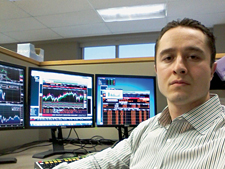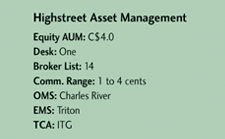Some people start small. Not Rob Pulkys, head trader at Highstreet Asset Management. He started his trading career in 2007 at one of Canada’s largest investors, Ontario Teachers Pension Plan. He started there right out of college as a trader and worked for 20 portfolio managers, who invested across every asset class. Baptism by fire, indeed.

At Ontario Teachers, Pulkys had the fund’s clout-roughly C$100 billion then-to help him get his trades done. His timing couldn’t have been better: Not only did he start at one of Canada’s premier investors, but he also had the benefit of trading equities in a radically changing market. He traded both U.S. and Canadian stocks.
"I came right into the business during its big changes in 2007," Pulkys said. It was then, as he was earning his trading stripes, that Reg NMS was being implemented in the U.S. and technology grabbed hold of the trading world. Pulkys was ready to embrace the new electronic trading paradigm.
Pulkys said that his being new to the business actually worked to his advantage, as he was learning the changing equity trading business the same time as everyone else. Consequently, he didn’t have to break old trading habits.

Pulkys was hired by 42-year veteran Sally Fulton, who was progressive during that time because she embraced the new technology, he said. Fulton taught Pulkys to be nimble and to embrace changes in all equities markets. He fondly remembers his first execution management system at Ontario Teachers, Triton, which he uses at Highstreet-the firm he joined in October of 2011.
"[Ontario Teachers] had the Triton EMS on the desk before most others in Canada," he said. He also learned to use another new option in Canada: dark pools. While already firmly established in the U.S., in 2007 only ITG’s Match Now and Liquidnet were open for business in Canada.
Pulkys has always preferred executing his trades in the dark, whether trading for Ontario’s portfolio or Highstreet’s. Why?
"I’m worried about toxicity due to the high-frequency firms, as well as information leakage," he said. "In a perfect world, I would love to trade everything in the dark if I could. But I realize that’s not the reality, especially in Canada."
Pulkys executes about 10 to 25 percent of his flow offboard in Canada and 30 percent in the dark in America, where he finds greater liquidity in the names. He trades using algorithms 30 percent of the time.
While in the dark, he still looks for blocks, though they are harder to find in his smaller-cap universe. Pulkys employs about five liquidity-seeking algorithms to help him locate natural blocks, but more often he finds virtual blocks, which he trades nonetheless.
"We are agnostic as a firm as to where the flow comes from," Pulkys said. "I don’t care where the liquidity comes from as long as I can get it. Liquidity trumps other factors."




